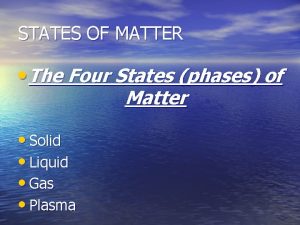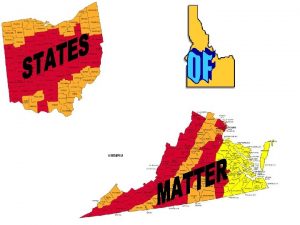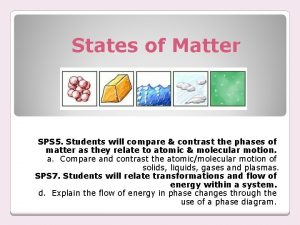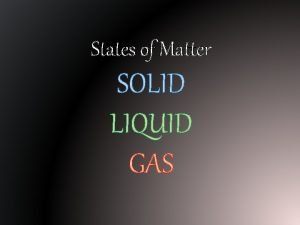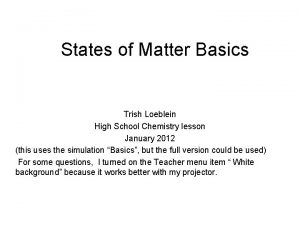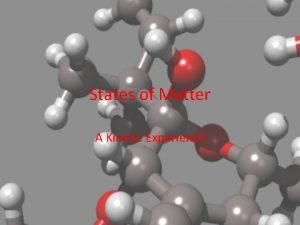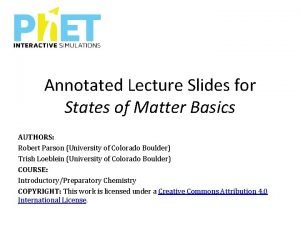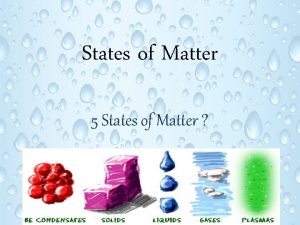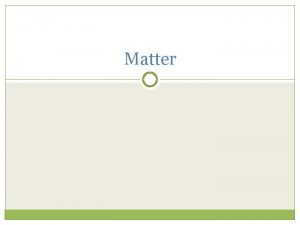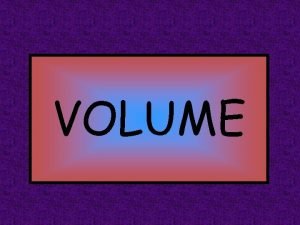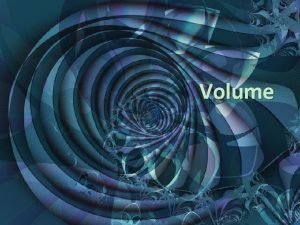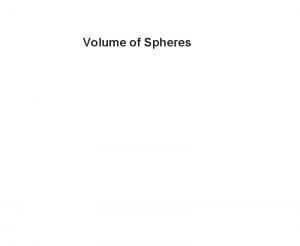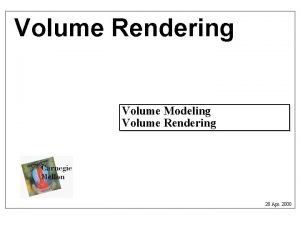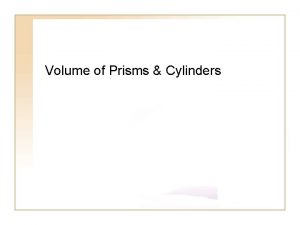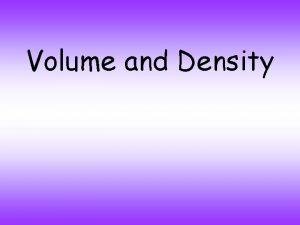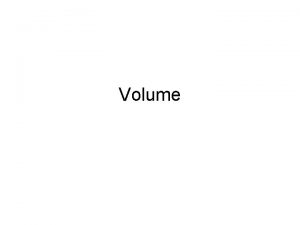Matter Volume States of Matter Their Properties Matter























- Slides: 23

Matter & Volume States of Matter & Their Properties

Matter: What’s it matter? Matter is anything that has mass and takes up space. The amount of _____ matter takes up is an object’s _______. Check out this water/sound activity. https: //www. youtube. com/watch? v=Dvk. ELEBMLV 0

Matter: What’s it matter? Matter is anything that has mass and takes up space. The amount of space matter takes up is an object’s _______. Check out this water/sound activity. https: //www. youtube. com/watch? v=Dvk. ELEBMLV 0

Matter: What’s it matter? Matter is anything that has mass and takes up space. The amount of space matter takes up is an object’s volume. Check out this water/sound activity. https: //www. youtube. com/watch? v=Dvk. ELEBMLV 0

Volume: Liquids The units of measurement for volume are Liters and Milliliters. What did we discuss in the first unit that was a measurement for volume? ______________ To accurately read a ______, (the curve at the surface of a liquid), you must read the _______ at the ______ part of the curve. ________ beakers make it hard to see the meniscus.

Volume: Liquids The units of measurement for volume are Liters and Milliliters. What did we discuss in the first unit that was a measurement for volume? Graduated cylinders To accurately read a ______, (the curve at the surface of a liquid), you must read the _______ at the ______ part of the curve. ________ beakers make it hard to see the meniscus.

Volume: Liquids The units of measurement for volume are Liters and Milliliters. What did we discuss in the first unit that was a measurement for volume? Graduated cylinders To accurately read a meniscus, (the curve at the surface of a liquid), you must read the _______ at the ______ part of the curve. ________ beakers make it hard to see the meniscus.

Volume: Liquids The units of measurement for volume are Liters and Milliliters. What did we discuss in the first unit that was a measurement for volume? Graduated cylinders To accurately read a meniscus, (the curve at the surface of a liquid), you must read the scale at the lowest part of the curve. ________ beakers make it hard to see the meniscus.

Volume: Liquids The units of measurement for volume are Liters and Milliliters. What did we discuss in the first unit that was a measurement for volume? Graduated cylinders To accurately read a meniscus, (the curve at the surface of a liquid), you must read the scale at the lowest part of the curve. Large beakers make it hard to see the meniscus.

Volume: Solids When we have a regularly-shaped object, we can find its ______ unit by multiplying ___________ by _______. The unit’s expression: ________ is the method for discovering volume of an _________ object. Find number at the line. Insert object. Find new number. Subtract numbers. This is your volume.

Volume: Solids When we have a regularly-shaped object, we can find its cubic unit by multiplying ___________ by _______. The unit’s expression: ________ is the method for discovering volume of an _________ object. Find number at the line. Insert object. Find new number. Subtract numbers. This is your volume.

Volume: Solids When we have a regularly-shaped object, we can find its cubic unit by multiplying length by width by height. The unit’s expression: ________ is the method for discovering volume of an _________ object. Find number at the line. Insert object. Find new number. Subtract numbers. This is your volume.

Volume: Solids When we have a regularly-shaped object, we can find its cubic unit by multiplying length by width by height. The unit’s expression: 1 m 3 ________ is the method for discovering volume of an _________ object. Find number at the line. Insert object. Find new number. Subtract numbers. This is your volume.

Volume: Solids When we have a regularly-shaped object, we can find its cubic unit by multiplying length by width by height. The unit’s expression: 1 m 3 Displacement is the method for discovering volume of an irregular object. Find number at the line. Insert object. Find new number. Subtract numbers. This is your volume.

Practice! A book has a length of 25 cm, a width of 18 cm, and a height of 4 cm. What is its volume? What is the volume of a suitcase that has a length of 95 cm, a width of 50 cm, and a height of 20 cm? A CD case is 14. 2 cm long, 12. 4 cm wide, and 1 cm deep. What is its volume?

Mass V. Weight Mass: A measure of the amount of ______ in an object Weight: A measure of the __________ force on an object. Mass: _______ for an object, no matter its location Weight: _______ depending on its relation to earth Mass: Measured by using a ________. Weight: Measure by using a ___________. Mass: Expressed in ______. Weight: Expressed in _______.

Mass V. Weight Mass: A measure of the amount of matter in an object Weight: A measure of the __________ force on an object. Mass: _______ for an object, no matter its location Weight: _______ depending on its relation to earth Mass: Measured by using a ________. Weight: Measure by using a ___________. Mass: Expressed in ______. Weight: Expressed in _______.

Mass V. Weight Mass: A measure of the amount of matter in an object Weight: A measure of the gravitational force on an object. Mass: _______ for an object, no matter its location Weight: _______ depending on its relation to earth Mass: Measured by using a ________. Weight: Measure by using a ___________. Mass: Expressed in ______. Weight: Expressed in _______.

Mass V. Weight Mass: A measure of the amount of matter in an object Weight: A measure of the gravitational force on an object. Mass: Constant for an object, no matter its location Weight: _______ depending on its relation to earth Mass: Measured by using a ________. Weight: Measure by using a ___________. Mass: Expressed in ______. Weight: Expressed in _______.

Mass V. Weight Mass: A measure of the amount of matter in an object Weight: A measure of the gravitational force on an object. Mass: Constant for an object, no matter its location Weight: Varies depending on its relation to earth Mass: Measured by using a ________. Weight: Measure by using a ___________. Mass: Expressed in ______. Weight: Expressed in _______.

Mass V. Weight Mass: A measure of the amount of matter in an object Weight: A measure of the gravitational force on an object. Mass: Constant for an object, no matter its location Weight: Varies depending on its relation to earth Mass: Measured by using a balance. Weight: Measure by using a ___________. Mass: Expressed in ______. Weight: Expressed in _______.

Mass V. Weight Mass: A measure of the amount of matter in an object Weight: A measure of the gravitational force on an object. Mass: Constant for an object, no matter its location Weight: Varies depending on its relation to earth Mass: Measured by using a balance. Weight: Measure by using a spring scale. Mass: Expressed in ______. Weight: Expressed in _______.

Mass V. Weight Mass: A measure of the amount of matter in an object Weight: A measure of the gravitational force on an object. Mass: Constant for an object, no matter its location Weight: Varies depending on its relation to earth Mass: Measured by using a balance. Weight: Measure by using a spring scale. Mass: Expressed in kg, g, & mg. Weight: Expressed in N.
 Properties of matter definition
Properties of matter definition Slave states free states
Slave states free states Southern vs northern states
Southern vs northern states How does the constitution guard against tyranny
How does the constitution guard against tyranny Cardiac output
Cardiac output End-diastolic volume vs end-systolic volume
End-diastolic volume vs end-systolic volume Solute vs solvent
Solute vs solvent Closing volume vs residual volume
Closing volume vs residual volume Volume tabung kerucut
Volume tabung kerucut Large volume parenterals contain
Large volume parenterals contain Whats the study of matter and energy
Whats the study of matter and energy Four states of matter
Four states of matter Four states of matter
Four states of matter 5 states of matter
5 states of matter Thermal energy in states of matter
Thermal energy in states of matter Changing state
Changing state Phet states of matter basics
Phet states of matter basics 5 states of matter
5 states of matter Venn diagram of solid liquid gas
Venn diagram of solid liquid gas The kinetic theory of matter states that
The kinetic theory of matter states that Chapter 12 states of matter study guide
Chapter 12 states of matter study guide Chapter 10 review states of matter section 4
Chapter 10 review states of matter section 4 States of matter basics
States of matter basics States of matter foldable
States of matter foldable











